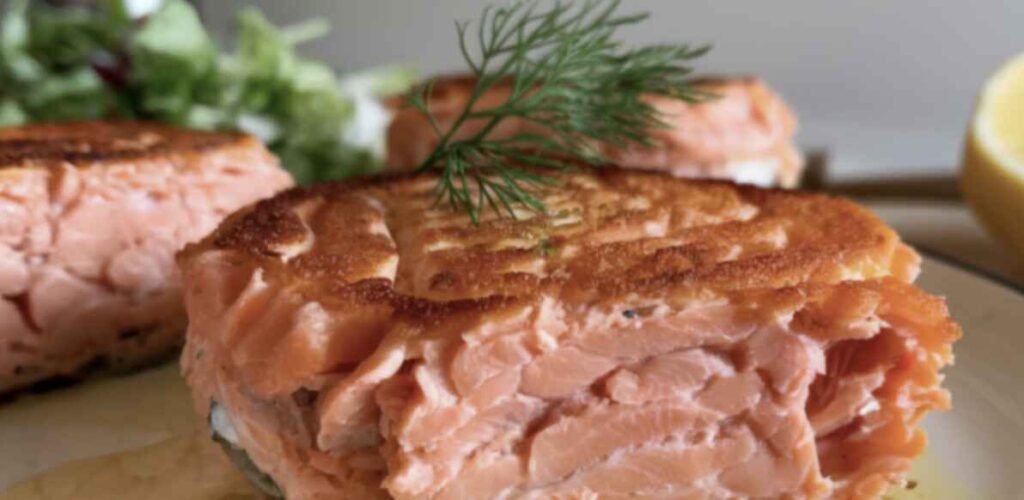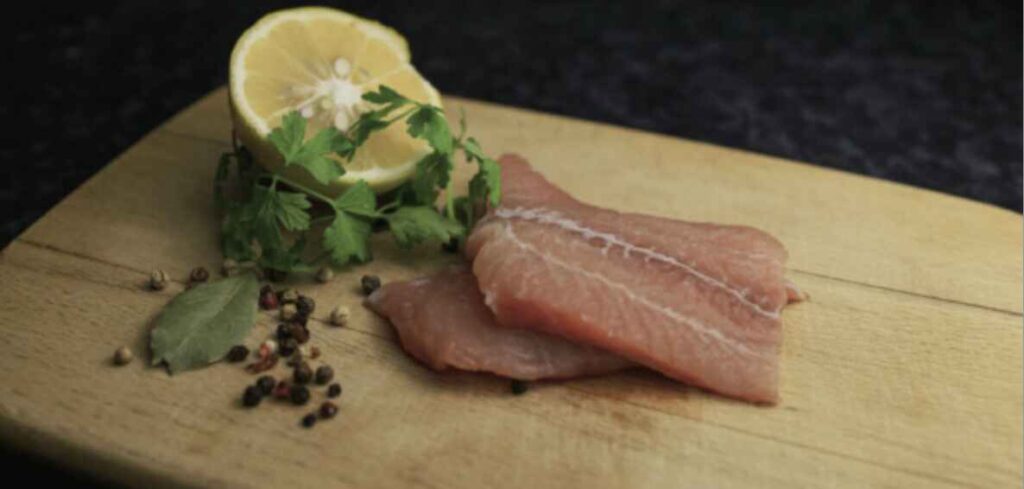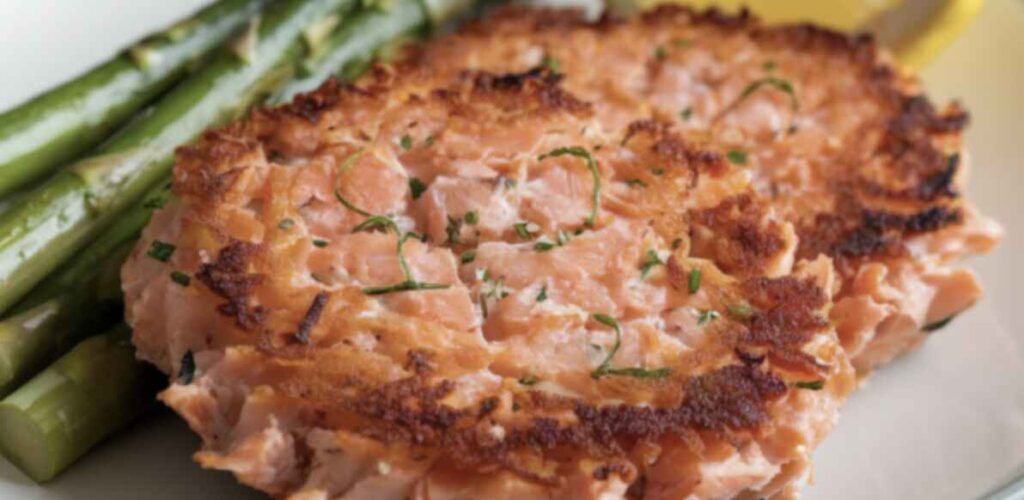Crumbling is a common issue when preparing salmon patties, often frustrating cooks and leading to uneven or broken patties. To prevent this, it’s essential to understand the factors contributing to their lack of cohesion.
Table of Contents
Understanding the Common Causes of Crumbling of Salmon Patties
1. Insufficient Binding Agents
- Eggs: Eggs act as a glue in the mixture. If you don’t use enough eggs, the patties may fall apart.
- Dry Binders: Ingredients like breadcrumbs, crushed crackers, or flour help absorb excess moisture and add structure. A lack of these can result in loose, crumbling salmon patties.
2. Excess Moisture
- Drained Salmon: Canned or fresh salmon may contain residual liquid that weakens the mixture. Improperly draining the salmon can make the patties too wet.
- Wet Ingredients: Overuse of mayonnaise, sauces, or vegetables with high water content can lead to excess moisture.
3. Improper Mixing
- Uneven mixing can leave some parts of the mixture under-bound while others are over-bound. This imbalance causes structural instability during cooking.
4. Overhandling or Overcooking
- Overhandling: Shaping the patties too aggressively can weaken their integrity, making them prone to breaking.
- Overcooking: Cooking the patties too long or at too high a temperature can dry them out, causing them to crumble.
Tips to Prevent Crumbling
- Use Sufficient Binders: Include one egg and about ½ cup of breadcrumbs or crackers per 1 pound of salmon.
- Drain Well: Ensure salmon is properly drained to avoid excess liquid.
- Chill the Mixture: Refrigerate the mixture for 15–30 minutes to firm it up before shaping.
- Gentle Handling: Shape patties with light hands and avoid flipping too often during cooking.
- Cook at Moderate Heat: Use medium heat to cook patties evenly without drying them out.
By addressing these common causes, you can create perfectly cohesive and delicious salmon patties that hold their shape and texture every time.
Lack of Binding Ingredients
When making salmon patties, a lack of proper binding ingredients can cause them to fall apart during cooking. Binding ingredients are essential to hold the mixture together and ensure the patties maintain their shape.
Common Causes of Poor Binding in Salmon Patties

- Insufficient Binders: Not adding enough eggs, breadcrumbs, or other binding agents can result in a loose mixture.
- Too Much Moisture: Excess liquid from canned salmon, sauces, or wet ingredients can weaken the binding.
- Improper Mixing: Unevenly mixing the ingredients can prevent the binder from evenly distributing throughout the mixture.
Effective Binding Solutions
- Eggs: Use at least one egg to act as a natural binder.
- Breadcrumbs or Crackers: Add breadcrumbs, crushed crackers, or even oats to absorb moisture and improve cohesion.
- Chilling the Mixture: Let the mixture rest in the refrigerator for 15–30 minutes to firm up before shaping.
By ensuring the right balance of binding ingredients, you can make salmon patties that are firm, well-structured, and easy to cook without crumbling.
Overcooking the Salmon Patties
Overcooking is a frequent issue that can cause salmon patties to dry out and crumble. When cooked too long or at too high a temperature, the moisture inside the patties evaporates, leaving them brittle and prone to breaking apart.
Why Overcooking Causes Crumbling
- Loss of Moisture: Extended exposure to heat removes the natural oils and moisture from the salmon and binding agents, reducing cohesiveness.
- Weakened Structure: Dryness caused by overcooking makes the patties fragile and more likely to break when flipped or handled.
How to Avoid Overcooking
- Moderate Heat: Cook salmon patties over medium heat to ensure even cooking without drying them out.
- Timing: Cook each side for 3–4 minutes or until golden brown. Avoid leaving them on the heat for too long.
- Oil the Pan: Use a small amount of oil to prevent the patties from sticking and breaking when flipped.
- Watch Closely: Keep a close eye on the patties to prevent overbrowning or burning.
By cooking at the right temperature and for the appropriate amount of time, you can maintain the moisture and integrity of your salmon patties, ensuring they stay intact and flavorful.
Incorrect Cooking Techniques

Improper cooking techniques can lead to crumbling salmon patties, resulting in a disappointing texture and appearance. Understanding and avoiding these mistakes is crucial for achieving well-formed and flavorful patties.
Common Cooking Mistakes
- Flipping Too Soon
- Turning the patties before they are fully set on one side can cause them to fall apart. The surface needs to form a firm crust before flipping.
- Flipping Too Often
- Constant flipping disrupts the patties’ structural integrity, making them prone to breaking apart.
- Using Too High Heat
- High heat can char the exterior while leaving the inside undercooked, compromising the cohesion of the patties.
- Not Using Enough Oil
- Cooking without sufficient oil can cause the patties to stick to the pan, leading to breakage when attempting to remove or flip them.
- Overcrowding the Pan
- Placing too many patties in the pan at once reduces the available cooking space and makes it harder to handle them without crumbling.
Tips for Correct Cooking Techniques

- Preheat the Pan: Ensure the pan is heated to medium before adding the patties for an even sear.
- Use Enough Oil: Lightly coat the pan with oil or butter to prevent sticking.
- Flip Carefully: Wait until the edges look golden and crisp, then gently flip the patties using a wide spatula.
- Cook in Batches: Leave enough space between patties to maneuver them easily in the pan.
- Monitor Heat: Maintain medium heat to cook the patties evenly without drying them out or burning the outside.
By adopting proper cooking techniques, you can create salmon patties that hold their shape, cook evenly, and deliver a deliciously satisfying texture.
Key Ingredients to Prevent Crumbling
To ensure salmon patties stay intact during preparation and cooking, using the right ingredients for binding and structure is crucial. These key components provide cohesion, absorb moisture, and enhance the texture of the patties.
1. Eggs
- Role: Eggs act as a natural binder, holding the ingredients together.
- Usage Tip: Use at least one egg per pound of salmon for optimal binding. If the mixture feels too loose, an additional egg can help.
2. Breadcrumbs or Crushed Crackers
- Role: These dry ingredients absorb excess moisture and add structural integrity to the patties.
- Usage Tip: Add about ½ cup of breadcrumbs or crushed crackers per pound of salmon. Panko breadcrumbs are a popular choice for their light texture.
3. Flour or Cornmeal
- Role: These act as secondary binding agents and help give the patties a firmer texture.
- Usage Tip: Lightly coat the patties with flour or cornmeal before frying for added stability and a crisp exterior.
4. Mayonnaise or Greek Yogurt
- Role: These ingredients add moisture and help bind the mixture without making it too dry.
- Usage Tip: Use sparingly to balance moisture and binding; 1–2 tablespoons per pound of salmon is sufficient.
5. Mashed Potatoes or Cooked Rice
- Role: Starchy additions like potatoes or rice can serve as both a filler and a binder, ensuring the mixture holds together.
- Usage Tip: Add about ½ cup of mashed potatoes or rice per pound of salmon for a hearty, cohesive texture.
6. Fresh Herbs and Aromatics
- Role: While primarily for flavor, finely chopped herbs, onions, or garlic must be balanced with binders to prevent weakening the patties.
- Usage Tip: Ensure these ingredients are finely minced and not added in excess to avoid overwhelming the binding agents.
7. Chilling the Mixture
- Role: While not an ingredient, refrigerating the mixture for 15–30 minutes allows it to firm up, making it easier to shape and cook without crumbling.
By incorporating these key ingredients and techniques, you can create salmon patties that are well-structured, flavorful, and resistant to crumbling during cooking.
The Role of Eggs as a Binder
Eggs are one of the most effective and commonly used binding agents in salmon patties. They play a crucial role in holding the ingredients together, ensuring the patties maintain their shape during preparation and cooking.
How Eggs Work as a Binder
- Protein Network: When cooked, the proteins in eggs coagulate and form a network that binds the ingredients together.
- Adhesive Properties: Eggs create a sticky texture in the mixture, helping to hold loose ingredients like salmon, breadcrumbs, and herbs in place.
- Moisture Balance: Eggs add just enough moisture to keep the patties soft and pliable without making them too wet or crumbly.
Tips for Using Eggs as a Binder
- Quantity: Use at least one egg per pound of salmon. If the mixture feels too loose, adding an extra egg can improve cohesion.
- Whisk Before Adding: Lightly whisk the egg before incorporating it into the mixture to ensure even distribution.
- Balance Ingredients: Pair eggs with dry binders like breadcrumbs or flour to avoid excess moisture, which can weaken the mixture.
Alternatives to Eggs
For those with dietary restrictions, the following can be used as egg substitutes:
- Flaxseed Meal: Mix 1 tablespoon of flaxseed meal with 2.5 tablespoons of water to replace one egg.
- Mashed Potatoes: Add ¼ cup of mashed potatoes for a similar binding effect.
- Mayonnaise: Use 1–2 tablespoons of mayonnaise as a binder.
Cooking Methods to Maintain Structural Integrity
Pan-Frying for Even Heat Distribution
Cook patties over medium heat with a small amount of oil to create a crisp, golden exterior. Allow each side to cook for 3–4 minutes before flipping to avoid breakage.
Oven-Baking as a Gentle Alternative
For a healthier option, bake patties at 375°F (190°C) for 15–20 minutes, flipping halfway through. This method provides even cooking with less handling.
Avoiding Excessive Flipping During Cooking
Flip the patties only once to maintain their shape. Wait until the edges are golden and set before flipping.
Additional Tips for Perfect Salmon Patties
Using Fresh or Canned Salmon
Both fresh and canned salmon work well, but canned salmon should be thoroughly drained to avoid excess moisture. Remove any skin or bones for a smoother texture.
Testing for Doneness Without Overcooking
Patties are done when the internal temperature reaches 145°F (63°C) or when they feel firm to the touch. Avoid overcooking, which can cause dryness and crumbling.
Frequently Asked Questions
Why do my salmon patties fall apart?
This typically occurs due to insufficient binders, excess moisture, or improper handling during cooking. Adding enough eggs and breadcrumbs, draining salmon thoroughly, and chilling the patties can help.
Can I make salmon patties without eggs?
Yes! Substitutes like flaxseed meal (1 tablespoon mixed with 2.5 tablespoons of water) or mashed potatoes (¼ cup per egg) can provide similar binding properties.
How long should I chill the patties?
Chill for at least 15 minutes, but up to 30 minutes for firmer results.
Can I use gluten-free alternatives?
Absolutely. Gluten-free breadcrumbs or crushed rice crackers work well as substitutes for regular breadcrumbs.
What’s the best way to store leftover patties?
Refrigerate cooked patties in an airtight container for up to three days. For longer storage, freeze them for up to three months.
Do canned and fresh salmon behave differently?
Yes. Canned salmon is often softer and requires thorough draining. Fresh salmon, on the other hand, provides a firmer texture.
For more tips and inspiration, explore our curated resources linked throughout this guide! Whether you’re looking for traditional recipes, expert cooking techniques, or guidance on selecting the freshest salmon, these articles provide the perfect complement to mastering your salmon patties. Click on the highlighted links to dive deeper into making your dishes unforgettable!
- Perfect Salmon Patties: Tips, FAQs, and Delicious Recipes – To expand on techniques and common questions about making salmon patties.
- https://recipeslime.com/old-fashioned-salmon-patties-recipe-a-delicious-family-favorite/ – To provide a detailed recipe for readers who want a traditional approach.
- Grilled Salmon with Herbs: The Ultimate Guide – To offer grilling techniques and flavor ideas that complement salmon patties.
- Fish: The Ultimate Guide to Make the Right Choice – To guide readers in selecting quality fish for their patties.
Conclusion: Your Guide to Perfect Salmon Patties
By combining the right ingredients, using proper techniques, and avoiding common mistakes, you can master the art of making salmon patties. Whether pan-fried or baked, with fresh or canned salmon, these tips will help you create patties that are firm, flavorful, and perfectly cooked every time.

